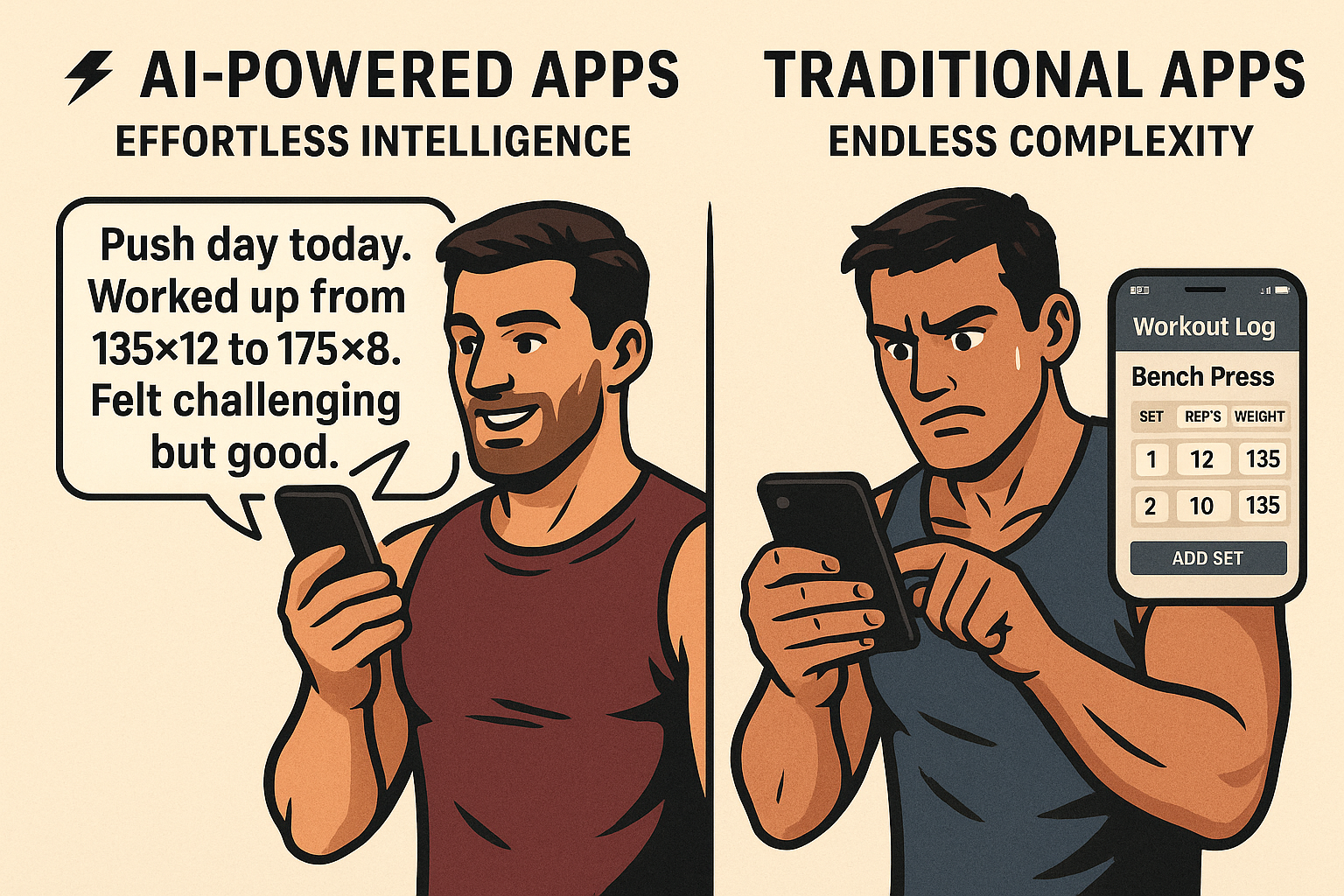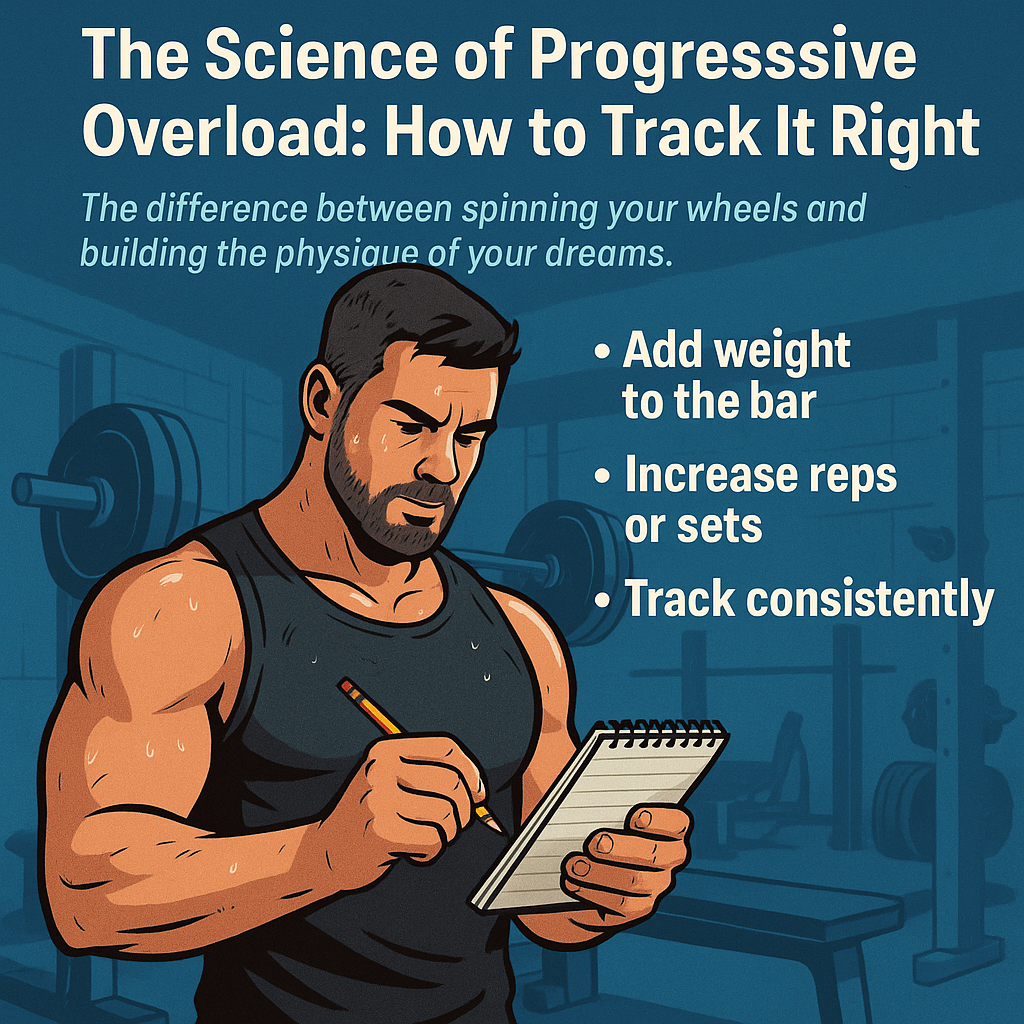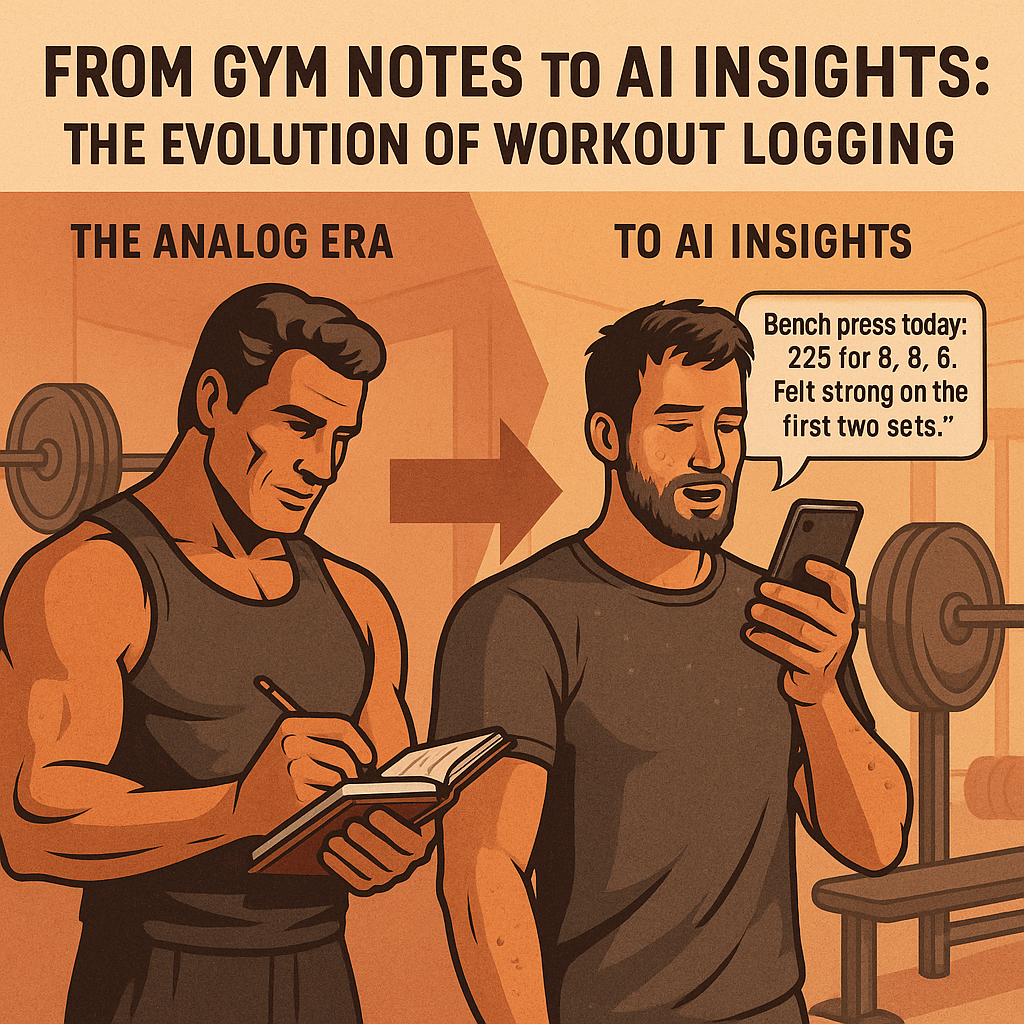AI vs Traditional Fitness Apps: Why Intelligence Beats Complexity
The choice between endless complexity and effortless intelligence. Guess which one actually gets results.
You download a new fitness app with high hopes.
"This time will be different," you tell yourself. "This time I'll finally track everything consistently."
Fast forward two weeks: You're staring at your phone between sets, frantically tapping through 4 different screens just to log one exercise. Your workout momentum is dead. Your motivation is fading. And you're wondering why every fitness app feels like solving a Rubik's cube while bench pressing.
Sound familiar?
Here's the uncomfortable truth: Traditional fitness apps are broken by design. They're built by engineers who think more features = better product. But in the gym, complexity is the enemy of consistency.
The future belongs to AI-powered apps that understand a simple principle: Intelligence beats complexity, every single time.
The Traditional Fitness App Disaster
📱 The Feature Frankenstein
Traditional fitness apps suffer from what I call "Feature Frankenstein Syndrome." They bolt on every possible feature:
- •2,000+ exercise database (you'll use maybe 20)
- •Macro calculators with 47 input fields
- •Social feeds nobody actually uses
- •Workout builders that take longer than your actual workout
- •Analytics dashboards that confuse more than they clarify
The result? Apps so bloated they take 30 seconds just to load your workout screen.
🧠 The Cognitive Load Catastrophe
Here's your typical traditional app experience:
`
Your "Simple" Workout Log:
1. Open app (wait 30 seconds for loading)
2. Navigate to "Start Workout"
3. Search for "bench press" among 500+ exercises
4. Select the right variation (flat? incline? dumbbell?)
5. Input sets: 3
6. Input reps for set 1: 12
7. Input weight for set 1: 135
8. Input RPE for set 1: 7
9. Input rest time: 3 minutes
10. Repeat steps 6-9 for each set
11. Repeat entire process for 6-8 exercises
12. Give up halfway through and stop tracking
`
Time to log one exercise: 3-5 minutes
Mental energy spent: High
Likelihood you'll do this consistently: Near zero
📊 The Abandonment Epidemic
The fitness app industry has a dirty secret: 90% of users abandon fitness apps within the first month.
Not because people don't want to track their workouts. Not because they're lazy. But because the tools fight against human nature instead of working with it.
Enter the AI Revolution 🤖
What if tracking your workout felt like having a conversation with your training partner?
"Just crushed bench press today. Started with 135 for 12, moved up to 155 for 8, then hit 175 for 5. Felt strong."
That's it. No forms. No menus. No breaking your flow. Just natural human communication with an AI that actually understands fitness.
🎯 How AI Changes the Game
Traditional App Thinking:
"Here are 47 fields to fill out for maximum data accuracy."
AI App Thinking:
"Tell me about your workout like you'd tell a friend."
Natural Language Magic
Your AI training partner speaks fluent gym:
- •*"Hit legs today"* → Leg workout detected ✅
- •*"Crushed shoulders"* → Shoulder exercises logged ✅
- •*"PR on bench"* → Personal record celebration mode activated ✅
- •*"185 for 8, 8, 6"* → 3 sets automatically structured ✅
Context Intelligence
AI understands your training world:
- •Numbers over 100 = weight (pounds or kg based on your location)
- •"Heavy single" = 1-rep max attempt
- •"Drop set" = descending weight protocol
- •"Felt easy" = RPE 6-7 range
- •"Grinder" = RPE 9-10 range
Pattern Learning
Your AI gets smarter with every workout:
- •Learns your typical rep ranges
- •Remembers your preferred exercise variations
- •Adapts to your training schedule
- •Predicts your next progression
The Head-to-Head Reality Check
Let me paint you the real picture:
⚡ AI-Powered Apps (The Future)
What you do:
- •Speak or type naturally during/after your workout
- •Review and confirm the AI's interpretation
- •Get intelligent insights about your progress
Time investment: 30-60 seconds per workout
Mental load: Zero
Consistency rate: 85%+ after 3 months
User satisfaction: "Finally, technology that gets it"
🐌 Traditional Apps (The Past)
What you do:
- •Navigate complex menus during your workout
- •Fill out detailed forms for every single set
- •Fight with the app's rigid structure
- •Abandon the system within weeks
Time investment: 10-20 minutes per workout
Mental load: High cognitive overhead
Consistency rate: <30% after 1 month
User satisfaction: "This is more work than my actual workout"
Real-World Usage Patterns (The Truth Hurts)
📉 Traditional App Death Spiral
`
Week 1: "I'm going to log EVERYTHING!" (20 min/workout)
Week 2: "This is getting tedious..." (15 min/workout)
Week 3: "I'll just log the main lifts" (10 min/workout)
Week 4: "Ugh, this is so annoying" (5 min/workout)
Week 6: App deleted from phone
`
📈 AI App Success Trajectory
`
Week 1: "This is actually easy" (2 min/workout)
Week 2: "Getting the hang of speaking naturally" (90 sec/workout)
Week 3: "AI totally gets my training style" (60 sec/workout)
Week 4: "Completely integrated into my routine" (30 sec/workout)
Month 6: "Can't imagine training without this"
`
The Science of Why This Works
🧠 Cognitive Load Theory
Research in human performance shows:
- •High cognitive demand during exercise kills performance
- •Task switching (workout → phone → workout) breaks flow states
- •Friction in habit formation leads to abandonment
AI solution: Zero cognitive load. Pure focus on your training.
⏱️ The Two-Minute Rule
Behavioral psychology teaches us: If a habit takes longer than 2 minutes, it's likely to fail.
- •Traditional logging: 10-20 minutes (guaranteed failure)
- •AI logging: 30-60 seconds (sustainable success)
The Practical Example That Says It All
Scenario: You just finished a push workout.
🔴 Traditional App Experience:
[Opens app, waits for loading]
[Taps "Start Workout"]
[Searches exercise database for "bench press"]
[Selects "Barbell Bench Press - Flat"]
[Inputs: Sets: 3, Reps: 12, Weight: 135, RPE: 7, Rest: 3min]
[Repeats for set 2: Reps: 10, Weight: 155, RPE: 8]
[Repeats for set 3: Reps: 8, Weight: 175, RPE: 9]
[Searches for "overhead press"]
[Continues this process for 6 more exercises]
Total time: 18 minutes
Your thoughts: "This is exhausting. I'm never doing this again."
🟢 AI App Experience:
[Opens app or uses voice while resting]
"Push day today. Bench press: worked up from 135×12 to 155×10 to 175×8. Felt challenging but good. Then overhead press, incline dumbbells, lateral raises, tricep work, and some abs."
[AI processes and asks: "Sounds like a solid push session! Want me to log specific weights for the other exercises or keep it general?"]
"Keep it general for now."
[Reviews auto-generated workout log, taps confirm]
Total time: 90 seconds
Your thoughts: "That was effortless. I can definitely keep this up."
Why Your Gains Depend on This Choice
🎯 Consistency is Everything
The #1 factor in fitness success isn't your program, your genetics, or your supplements.
It's consistency.
The best workout tracker is the one you actually use. Period.
- •Traditional apps: Perfect data, terrible consistency
- •AI apps: Great data, amazing consistency
🧘 Focus on What Matters
During your workout, your brain should be focused on:
- •Form and technique
- •Progressive overload
- •Mind-muscle connection
- •Pushing your limits
NOT on:
- •Navigating app menus
- •Remembering exact numbers
- •Filling out digital forms
- •Fighting with technology
The Future is Already Here
🚀 What's Coming Next
The AI revolution is just getting started:
- •Computer vision analyzing your form in real-time
- •Biometric integration optimizing training based on recovery
- •Predictive analytics preventing plateaus before they happen
- •Conversational coaching that feels like having a personal trainer
🔮 The Inevitable Transition
Just like smartphones replaced flip phones, AI will replace traditional fitness apps.
The question isn't if this will happen. It's when you'll make the switch.
Early adopters are already seeing the benefits: better consistency, faster progress, and actually enjoying their tracking system.
Late adopters will eventually be forced to change when traditional apps become obsolete.
Which camp do you want to be in?
The Choice is Simple
You have two paths:
Path 1: Keep fighting with complex apps that treat you like a data entry clerk. Continue the cycle of download → brief excitement → abandonment → repeat.
Path 2: Embrace the future where technology adapts to you. Experience the freedom of natural language tracking. Actually stick with your system long enough to see real results.
The future of fitness tracking isn't about more features.
It's about removing friction while keeping the value.
It's about intelligence, not complexity.
It's about working with human nature, not against it.
Your gains are waiting on the other side of this decision.
Ready to stop fighting your tools and start improving your results? Try W8Log's AI-powered voice logging and experience what workout tracking should feel like.


